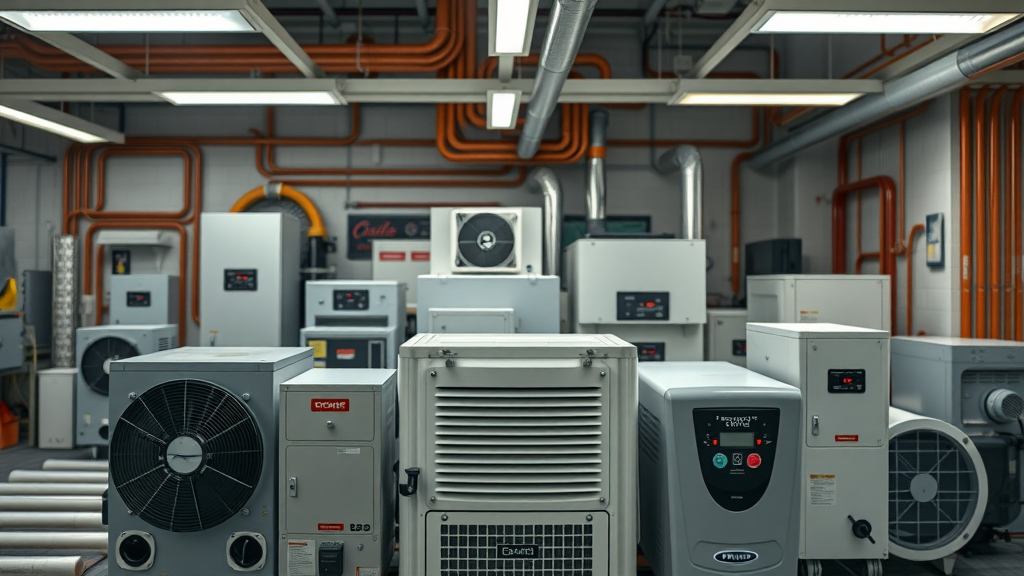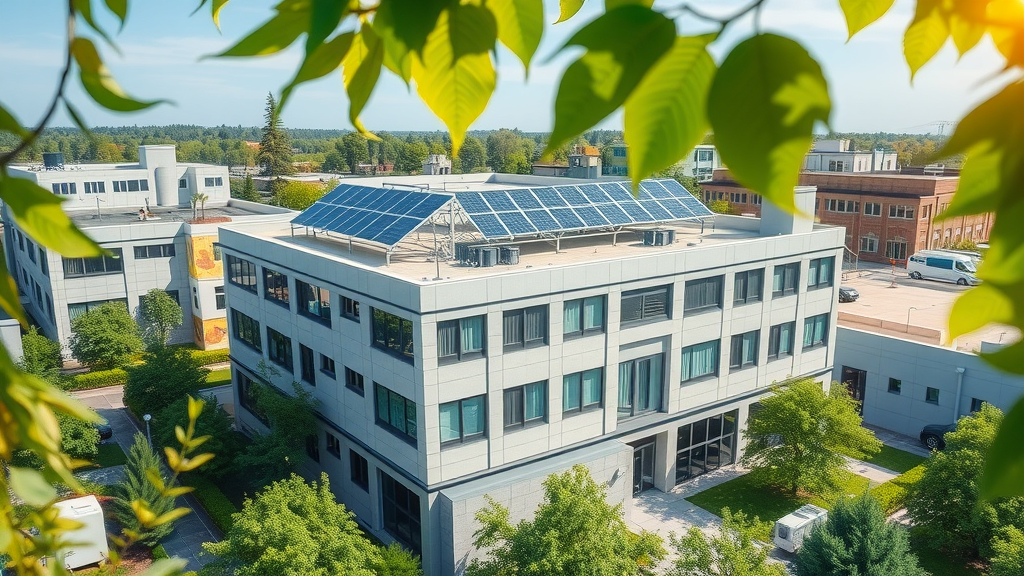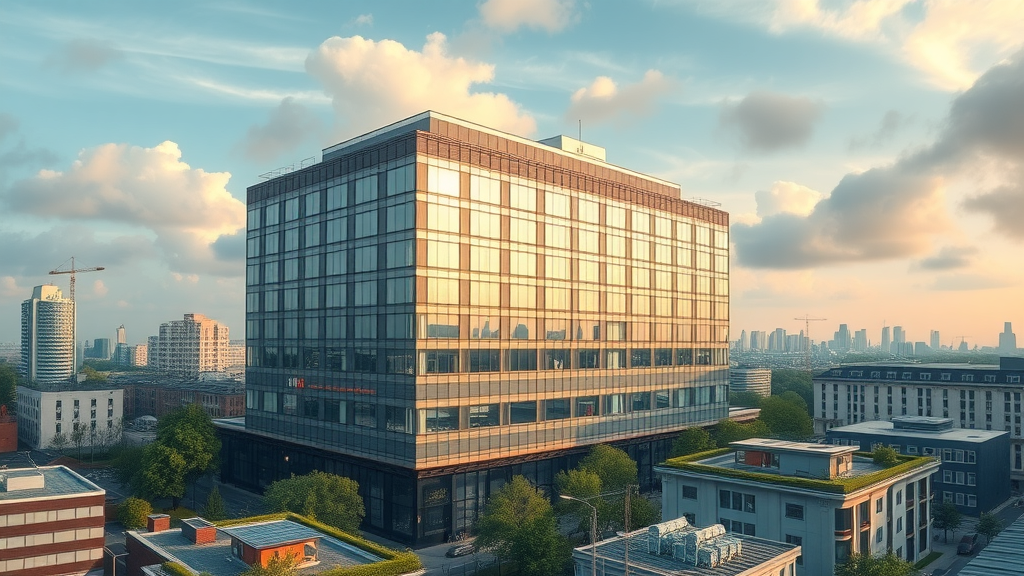An Eye-Opening Look at Commercial Building Heating Options (Opening Hook)
"Did you know that up to 60% of a commercial building’s energy use goes to heating? Choosing the right commercial building heating options can save thousands—and drastically shrink your carbon footprint."

When it comes to commercial building heating options, energy use and overhead costs can skyrocket if you choose the wrong system. But make the right choice, and you’ll enjoy lasting savings, improved comfort, and a sustainable reputation. Building owners are now faced with a wide array of heating system options—from innovative heat pumps and underfloor heating, to advanced warm air heating and traditional commercial boilers. Selecting the best fit isn’t just about keeping interiors warm; it’s a business decision impacting your costs, the environment, and even occupant health. In this detailed guide, you’ll discover not just the vast range of commercial heating systems, but also how to select the one that aligns with your building’s needs, efficiency goals, and compliance obligations. And most importantly—learn why underfloor heating is rapidly becoming the gold standard for commercial spaces.
What You'll Learn: Navigating Commercial Building Heating Options
- The most effective commercial building heating options for different properties
- How heating systems and heat pumps compare in efficiency
- Cost and environmental impacts of the main heating systems
- What makes underfloor heating a standout choice
- Professional guidance for commercial heating projects
Understanding Commercial Building Heating: Key Considerations
Every commercial property has unique heating needs, and the path to the right commercial building heating option starts with thorough analysis. The size and use of the building directly influence what types of commercial heating systems are practical and cost-effective. For example, a multi-storey office block will require a different heating solution compared to a retail space or warehouse. Energy efficiency goals are now front and centre—not only do governments enforce stricter regulations, but tenants expect eco-friendly and low-cost environments. An owner must consider typical costs and ROI for each system, weighing upfront investment against long-term operational savings.
Compliance and sustainability regulations can impact allowable heating systems, and increasingly, these policies reward or mandate low-carbon and efficient choices such as heat pump installations. Don’t overlook the significance of occupant comfort and building design: systems like underfloor heating offer even warmth throughout the building, enhance comfort, and can be tailored to fit unique architectural features. The smartest choice balances regulation, cost, longevity, and enhances both the daily experience and sustainability profile of your commercial building.
- Building size and use
- Energy efficiency goals
- Typical costs and ROI
- Compliance and sustainability regulations
- Occupant comfort and building design
Types of Commercial Building Heating Options: An Overview
There are different types of commercial building heating options designed to suit a wide range of environments and objectives. Main categories include central heating systems, warm air heating solutions, radiant and underfloor heating, advanced heat pumps, and traditional commercial boilers. Each brings advantages and unique considerations regarding energy efficiency, installation requirements, and suitability for modern or legacy buildings. Understanding these options ensures your property benefits from optimal space heating, energy savings, and future-ready technology.
| Technology Type | Best Use | Energy Efficiency | Installation Cost | Maintenance | Applications |
|---|---|---|---|---|---|
| Central Heating (Boiler Systems) | Large multi-room buildings | Moderate | Medium-High | Regular checks needed | Offices, Hotels, Schools |
| Warm Air Heating | Open-plan spaces | Good | Medium | Low-Moderate | Retail, Warehouses |
| Radiant/Underfloor Heating | All property sizes | Excellent | Medium-High | Minimal | Offices, Healthcare, Retail |
| Heat Pumps | Sustainable projects | Very High | High | Low | Retrofits, Modern builds |
| Commercial Boilers (Oil/Gas) | Older buildings | Fair | Lower | Regular servicing | Legacy properties, Warehouses |

Heating Systems for Commercial Buildings: Core Categories
1. Central Heating Systems for Commercial Use
Central heating systems remain a popular choice for large commercial buildings requiring consistent heat distribution. These systems, often powered by commercial boilers or advanced heat pump technology, are designed to circulate warm water or air throughout the building via an intricate network of pipes and ductwork. Centralised systems offer high reliability, particularly in multi-storey structures or complexes with diverse space heating requirements. Flexibility is also a key advantage; the system can be tailored to combine with air conditioning and ventilation units for greater efficiency. When integrated with smart controls and modern heat exchangers, central heating delivers even warmth, reduced maintenance, and predictable operating costs.
The main challenge with traditional central systems is their initial setup cost, which can be significant due to equipment, installation, and potential upgrades to energy source compatibility. However, choosing modern energy-efficient models, such as condensing boilers or hybrid heat pumps, helps commercial buildings meet strict energy efficiency targets, cut carbon emissions, and future-proof operations. Regular servicing is essential to ensure reliability and longevity. With new compliance standards, central heating technology now often incorporates low-carbon features, enhancing both property value and occupant comfort while maintaining steady commercial heat throughout the building.
2. Warm Air Heating and Air Heat Options
Warm air heating systems are especially effective in open-plan areas like warehouses, exhibition centres, and retail units. These systems work by drawing in cooler air, heating it through an energy source (commonly gas, electric, or heat pump), and then distributing the warm air using ductwork and high-efficiency fans. This method is excellent for rapidly heating large spaces and maintaining comfortable temperatures even during fluctuating outside conditions. Furthermore, advanced air heat technologies now boast improved energy efficiency and can be integrated with smart thermostats or Building Management Systems (BMS) for precise control.
While warm air heating can offer lower upfront costs compared to central water-based heating, ongoing operational expenses depend on energy tariffs and system efficiency. The systems are also suitable for rapid temperature changes and are preferred where zoning and targeted heat are critical for specific commercial space activities. Service intervals are straightforward and maintenance tends to be less disruptive. If reducing dust and improving air quality is a top priority, look for models with built-in filtration or couple air heating with advanced air conditioning. Choosing the right air heat option keeps maintenance simple while ensuring a flexible, responsive commercial heating system.
3. Radiant Heating and Underfloor Heating
Radiant heating, especially underfloor heating, has become increasingly popular among forward-thinking commercial property owners. Instead of heating the air, radiant systems warm objects and surfaces—creating uniform temperatures that feel natural and pleasant. Underfloor systems use a grid of hot water pipes or electric cables beneath the floor, gently radiating heat upwards. This results in ultra-efficient operation, across large areas and with minimal heat loss. In commercial spaces like offices, health clinics, educational facilities, and retail, underfloor heating not only enhances comfort but also frees up wall and floor space otherwise occupied by radiators or heating vents.
The standout qualities of underfloor heating are its impressive energy efficiency, exceptionally low maintenance, and compatibility with low-carbon heat sources, including heat pumps. It’s ideal for both new construction and retrofits, and modern systems are fast to install. Radiant heating, broadly, improves thermal comfort and can be paired with traditional systems or advanced controls for ultimate flexibility. For any commercial building aiming for top-tier comfort, sustainability, and future-ready heating, underfloor heating represents a standout, forward-thinking solution.
4. Heat Pump Solutions for Commercial Buildings
Heat pumps represent a revolution in commercial building heating options. These systems efficiently transfer heat energy from the air, ground, or water into the building using advanced heat exchange technology. The main types—air source, ground source, and water source heat pumps—all offer significant carbon emissions reduction compared to traditional oil or gas boilers. With very high energy efficiency ratings, heat pumps deliver substantial long-term savings, especially when paired with underfloor heating. Their performance is further enhanced by integration with modern building management systems and renewable energy sources, ensuring reliable, responsive space heating throughout the building.
Initial setup costs are higher, but heat pumps usually require minimal ongoing maintenance, provide even heating, and are extremely durable. More importantly, they future-proof your commercial building against evolving energy regulations, boosting both compliance and property prestige. Retrofitting heat pumps to existing properties or incorporating them into new builds is straightforward, often unlocking grants and government incentives. The combination of sustainability, operational savings, and long-term reliability makes commercial heat pumps a compelling heating system choice for today’s forward-looking property owners.
5. Commercial Boiler and Traditional Commercial Heat
The traditional heart of many commercial heating systems remains the commercial boiler. Whether powered by gas, oil, or electricity, commercial boilers have powered everything from legacy manufacturing facilities to modern office towers. Their main advantage lies in delivering large volumes of hot water or steam for substantial, continuous heat demands. Commercial boilers are robust, can handle high-output scenarios, and modern designs can integrate with zoned controls and improved burners for less fuel consumption and lower carbon emissions.
Despite their proven longevity and reliability, commercial boilers face modern challenges. They tend to have higher carbon emissions than heat pumps or radiant heating, often require regular maintenance, and are subject to evolving efficiency regulations. For retrofitting, replacement, or when system familiarity is crucial, commercial boilers remain a sensible option. However, more buildings are shifting to hybrid systems, coupling existing boilers with underfloor heating and heat pumps to optimise both cost and carbon performance.
Heat Pumps in Commercial Spaces: Efficiency and Sustainability
- Air source, ground source, and water source heat pumps
- When are heat pumps the best commercial building heating option?
- Integration with underfloor heating and existing heating systems
Heat pumps have emerged as a star player among commercial building heating options. Air source, ground source, and water source heat pumps are all designed to extract renewable heat from their environment and convert it into reliable indoor warmth. Air source heat pumps are typically easier and less expensive to install, making them perfect for many mid-sized commercial buildings. Ground source systems, a bit more complex, achieve higher energy efficiency and are ideal for larger sites with space for underground loops. Water source pumps are excellent for properties near water bodies or urban developments with shared energy infrastructure.
But when exactly are heat pumps the right choice? Commercial heat pumps excel when sustainability targets, low operating costs, and future compliance are key priorities. Their compatibility with modern heating systems (especially underfloor heating) boosts overall efficiency and comfort. Integration is seamless, supporting a hybrid approach where heat pumps cover base loads and traditional boilers handle peak demand. This synergy enables commercial spaces to enjoy continuous, even heat with drastically reduced energy bills and environmental impact. The ROI is boosted further by available government grants and incentives encouraging eco-friendly upgrades.
Why Underfloor Heating Stands Out Among Commercial Building Heating Options
"Underfloor heating delivers uniform warmth and impressive energy savings—making it one of the most advanced commercial building heating options available today."
- Benefits of underfloor heating in commercial space
- Compatibility with modern heating systems and heat pumps
- Expert installation: The Peak Underfloor Heating advantage
Underfloor heating is rapidly becoming the top choice for property owners seeking unmatched comfort, sleek design, and serious energy savings. Unlike radiant panels or convector radiators, underfloor systems vanish beneath your floors—releasing a consistent, gentle warmth that’s distributed evenly across the entire commercial space. No hot or cold spots, no noisy fans—just reliable comfort from edge to edge. What’s more, because underfloor heating operates effectively at lower temperatures, it pairs perfectly with heat pump technology. This synergy compounds your energy savings and can further lower running costs.
Professional installation is critical for achieving optimal performance, especially in complex commercial environments. With the right expertise, the system integrates seamlessly with your new or existing heating system. Peak Underfloor Heating Ltd stands out with in-depth experience, streamlined project management, and a reputation for exceeding regulatory and aesthetic requirements. For commercial buildings looking to set a new standard—whether it’s a new build or retrofit—underfloor heating by a trusted specialist is a compelling investment in efficiency, sustainability, and occupant satisfaction.

Comparing Commercial Building Heating Systems: Cost, Longevity, and Maintenance
It’s crucial to look beyond the sticker price when evaluating commercial building heating options. Each system carries a distinct blend of upfront installation cost, ongoing operational expenses, and lifespan. For instance, heat pumps and underfloor heating often have higher initial outlays but pay back over the years through minimal maintenance and lower energy consumption. In contrast, traditional commercial boilers can be more cost-effective up front, but usually incur greater maintenance needs and fuel costs over time. Choosing the best system is never just about immediate savings—it’s about calculating total cost of ownership, how quickly you can expect ROI, and the scale of disruption maintenance might create over the system’s life.
| System | Initial Cost | Operational Expenses | Maintenance Needs | Lifespan |
|---|---|---|---|---|
| Underfloor Heating (with Heat Pumps) | High | Very Low | Minimal | 30+ years |
| Commercial Heat Pumps | High | Low | Low | 20-25 years |
| Warm Air Heating | Medium | Moderate | Medium | 15-20 years |
| Commercial Boilers | Medium | High | High | 15-20 years |
Eco-Friendly and Sustainable Heating Systems for Commercial Buildings
- Reducing carbon emissions with new heating systems
- How commercial heat pumps and underfloor solutions deliver sustainability
- Grants, incentives, and compliance for commercial properties
Sustainability is more than a buzzword for modern commercial buildings; it’s a powerful driver of value, compliance, and tenant appeal. Upgrading to eco-friendly commercial heating systems—particularly heat pumps and underfloor heating—marks a significant reduction in operational carbon emissions. These systems harness renewable sources and operate efficiently, using lower energy input to generate the same (or better) comfort levels for your property. Pairing a commercial heat pump with underfloor heating offers best-in-class sustainability and can often be supplemented with on-site renewables such as solar panels.
Commercial properties implementing low-carbon heating can tap into various grants and incentives, accelerating payback and keeping them ahead of tightening environmental regulations. These measures not only future-proof your building but also attract climate-conscious clients and tenants. By choosing advanced heating systems, you are making a strategic investment—delivering cost savings, achieving ISO or BREEAM certifications, and building a stronger environmental brand image for your property.

Expert Insights: Selecting the Best Commercial Building Heating Option
"Our experience shows underfloor heating can outclass other heating systems for both new builds and retrofits, achieving significant operational cost savings." – Technical Specialist, Peak Underfloor Heating Ltd
- Working with advisors and consultants
- Identifying the optimal heating system for your needs
- The value of choosing a specialist in commercial heating systems
The most effective path to an ideal commercial building heating system begins with professional guidance. By working alongside experienced heating consultants, building owners gain access to advanced modelling, tailored system recommendations, and accurate cost assessments. These specialists assess everything—from property use and occupancy to unique energy goals and compliance pressures. In most cases, expert advisors point to hybrid and underfloor heating solutions for both comfort and long-term savings, leveraging technologies like heat pumps for maximum environmental and operational benefit.
Crucially, installation quality is just as important as system choice. A trusted commercial heating partner like Peak Underfloor Heating Ltd ensures seamless project delivery—from consultation through to aftercare. This expertise means fewer installation hassles, better flexibility during retrofits or new builds, and system designs that easily scale with your business or tenant needs. By partnering with a commercial heating system expert, you unlock superior performance, regulatory peace of mind, and ongoing support for years to come.

People Also Ask: Commercial Building Heating Options Explored
What types of heat are used in commercial buildings?
- Radiant heating, warm air heating, heat pumps, commercial boilers, underfloor heating, and hybrid commercial heating systems are commonly used according to building needs and efficiency targets.
Commercial properties utilise a range of heating systems, including radiant heating panels, underfloor heating, warm air and air heat solutions, heat pumps, traditional commercial boilers, and adaptable hybrid setups. The optimal system depends on property size, layout, and goals for energy efficiency and compliance.
What is the most efficient commercial heater?
- Underfloor heating with modern heat pumps is often considered the most efficient commercial building heating option due to low running costs, even heat distribution, and eco-friendly performance.
For maximum efficiency, underfloor heating paired with a heat pump provides even warmth, uses energy intelligently, and supports minimal operational costs. This combination is well regarded for reducing carbon emissions and future-proofing commercial buildings against regulatory challenges.
How are commercial properties heated?
- Commercial properties use centralized heating systems, heat pumps, radiant floor heating, and boilers depending on property size, use, and local regulations.
Most commercial properties opt for central heating (using boilers or chillers), advanced heat pumps (like air source or ground source), or radiant systems such as underfloor heating. The systems are chosen based on the property’s size, typical occupancy, compliance mandates, and required level of comfort throughout the building.
What are the four types of heating systems?
- The four primary systems are warm air heating, radiant heating, heat pumps, and commercial boilers.
Commercial buildings commonly use four main systems: warm air heating, radiant heating, heat pumps, and commercial boilers. Your specialist advisor can help determine the ideal solution based on application, energy goals, and integration needs.
List: Latest Trends in Commercial Building Heating Options
- Smart and adaptive heating controls
- Integration of renewable energy sources
- Low-carbon heating solutions
- Modular heating system design
- Enhanced comfort features for commercial spaces
The commercial heating landscape is evolving rapidly, with new solutions like modular and scalable system designs, connected management from your phone, and direct integration with solar, wind, or other renewable sources. Demand grows for low-carbon and smart heating, with a sharp focus on both environmental and tenant satisfaction gains.

Frequently Asked Questions about Commercial Building Heating Options
-
How do heating needs differ from residential buildings?
Commercial buildings have larger volumes, more complex zoning needs, and stricter compliance requirements. As a result, they often require centralised systems, scalable heat pumps, or robust underfloor solutions to maintain reliable, efficient warmth for varying use patterns. -
What are ongoing maintenance requirements?
Maintenance varies by system; underfloor and heat pump solutions require minimal attention, while traditional commercial boilers and warm air systems need regular servicing and occasional parts replacement for peak performance. -
Can underfloor heating be retrofitted to existing commercial properties?
Yes! Modern underfloor heating systems are designed for both new construction and retrofits. With smart installation techniques, disruption is minimal and can greatly enhance your building’s efficiency and comfort. -
Which heating systems qualify for government incentives?
Systems that significantly reduce carbon emissions (such as heat pumps and underfloor heating with renewable integration) often qualify for grants or rebates meant to encourage sustainable upgrades in commercial properties.
Key Takeaways: Choosing the Right Commercial Building Heating Option
- Assess space, usage, and efficiency needs
- Underfloor heating and heat pumps provide longevity and sustainability
- Expert installation ensures optimal outcomes
- Professional advice saves costs and guarantees compliance
Conclusion: Achieve Efficiency and Comfort with the Right Commercial Building Heating Options
"The future of commercial heating is sustainable, efficient, and expertly tailored—make the right choice for your building and your bottom line."
Contact Peak Underfloor Heating Ltd for Expert Advice on Commercial Building Heating Options
- It can be difficult to know exactly what system is best for your application so if you are still unsure please feel free to contact us and one of our consultant’s will be happy to discuss your exact requirement’s. Call 01246 387120, or Email us at info@peakunderfloorheating.com
Sources
- Carbon Trust – https://www.carbontrust.com/resources/heating-ventilation-and-air-conditioning-hvac-technology-overview
- UK Gov – https://www.gov.uk/guidance/non-domestic-renewable-heat-incentive
- CIBSE – https://www.cibse.org/
- Peak Underfloor Heating Ltd – https://www.peakunderfloorheating.com/commercial/
To enhance your understanding of commercial building heating options, consider exploring the following authoritative resources:
- “Energy-Efficient HVAC Systems for Commercial Buildings” (leecompany.com)
This article provides an in-depth look at various energy-efficient HVAC systems suitable for commercial buildings, including Variable Refrigerant Flow (VRF) systems, heat pumps, geothermal HVAC systems, and smart HVAC technologies. It discusses how these systems can lead to significant cost savings and improved energy efficiency.
- “Commercial Buildings: Sustainable Heating” (greencitytimes.com)
This resource explores sustainable heating options for commercial buildings, such as geothermal heating, solar heating, and district heating systems. It highlights the benefits of these systems, including high energy efficiency, minimal maintenance requirements, and reduced reliance on fossil fuels.
By delving into these resources, you’ll gain a comprehensive understanding of the various heating options available for commercial buildings, enabling you to make informed decisions that align with your energy efficiency and sustainability goals.
 Add Row
Add Row  Add
Add 









Write A Comment